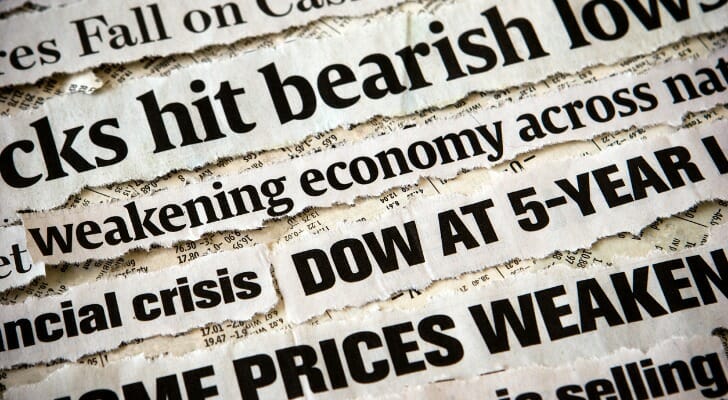With bonds and stocks selling off side by side, retirees may have a reason to fear their well-diversified portfolios may not prove enough for retirement. Fixed-income investments are experiencing one of the worst years in decades, and stocks have fallen roughly 17% year to date. According to investment research firm Morningstar, the 60/40 portfolio is performing the worst in 90 years. However, history indicates that recent retirees need not panic. Taking steps to protect your assets during a market downturn can relieve some of the pressure and keep your nest egg a little more secure. Here’s what you can do.
A financial advisor could help you plan for retirement and select investments that align with your financial goals. Speak to a qualified advisor today.
Historically Speaking, You Shouldn’t Panic When the Market Crashes
Research firm Morningstar says that all retirement savers should be aware of sequence of returns risk, because it can wreak havoc on your retirement plans. Sequence risk is the danger that retirement withdrawal timing will have a negative impact on the overall rate of a portfolio’s return.
When you have a long time horizon for investing, such as when you’re contributing to a retirement portfolio, what ultimately determines your portfolio’s results are the long-term average returns. But when you approach and enter retirement, starting to make portfolio withdrawals, the value of your portfolio reflects market performance plus cash outflows. Combining an extended market crash with withdrawals can very negatively affect the outlook of a retirement portfolio.

Nevertheless, history says that most well-diversified portfolios can and do recover over time. Morningstar data indicates that during the 1929 market crash – the worst in history – retirees with a stalwart 60/40 portfolio didn’t recover their values until 1945. The initial market crash affected those portfolios less than their equity-heavy counterparts since bond performance helped shore up returns. The worst happened in 1931, when the Federal Reserve hiked interest rates, and by 1932, an investor with $100,000 in a 60/40 portfolio would have seen the value drop by nearly half.
Other historic market crashes also demonstrate the power of sequence risk, or years of heavily negative returns. In the bear market of 1973, 60/40 investors would have seen the value of their portfolios drop an eye-popping 30% by the end of 1974. Yet despite the ongoing high inflation rate, reaching 12.3% in 1974, portfolio values would eventually recover by 1982.
Another long recovery came after the crash in 2000 when the dot com bubble burst. Not only did the stock market fall over three consecutive years, but shortly after, the 2008 financial crisis furthered the devastation. As a result, portfolios didn’t recover until 2013.
What Retirement Savers Can Do
Even though the situation may seem dire given the long time horizon to recovery, there are multiple ways to guard against asset depletion. For example, investors can avoid selling off assets in a down market by holding one to two years’ worth of planned withdrawals in cash. Worldwide, high-net-worth individuals often keep 21-28% of their assets in cash or cash equivalents, with the percentage leaning towards the higher end of the range during times of market crisis. This also opens an opportunity for better buys when the market eventually improves.
Being flexible with withdrawal rates is also key to mitigating sequence risk. Morningstar analysts recommend: withdrawing a fixed percentage of your portfolio’s value every year, not adjusting your withdrawal rate for inflation (i.e. not increasing your withdrawal percentage when inflation is high) or using a so-called guardrail approach where you reduce your withdrawal rate if it surpasses a set threshold.
Bottom Line

Investment research firm Morningstar warns against the power of sequence risk, which can significantly affect retirees and their long-term retirement outlook. Historical records indicate that major stock market crashes wiped double-digit values from investment portfolios and recovery took roughly 10 years. However, 60/40 retirement savers can protect their investments from such risk by keeping a certain amount of assets in cash and adjusting withdrawal rates as necessary.
Retirement Planning Tips
- Not sure if you have enough saved for retirement? For a solid, long-term financial plan, consider speaking with a qualified financial advisor. Finding a qualified financial advisor doesn’t have to be hard. SmartAsset’s free tool matches you with up to three financial advisors who serve your area, and you can interview your advisor matches at no cost to decide which one is right for you. If you’re ready to find an advisor who can help you achieve your financial goals, get started now.
- Use SmartAsset’s free retirement calculator to get a good first estimate of how much money you’ll need to retire.
Photo credit: ©iStock.com/Keith Lance, ©iStock.com/Carlos Pascual, ©iStock.com/Cecilie_Arcurs
